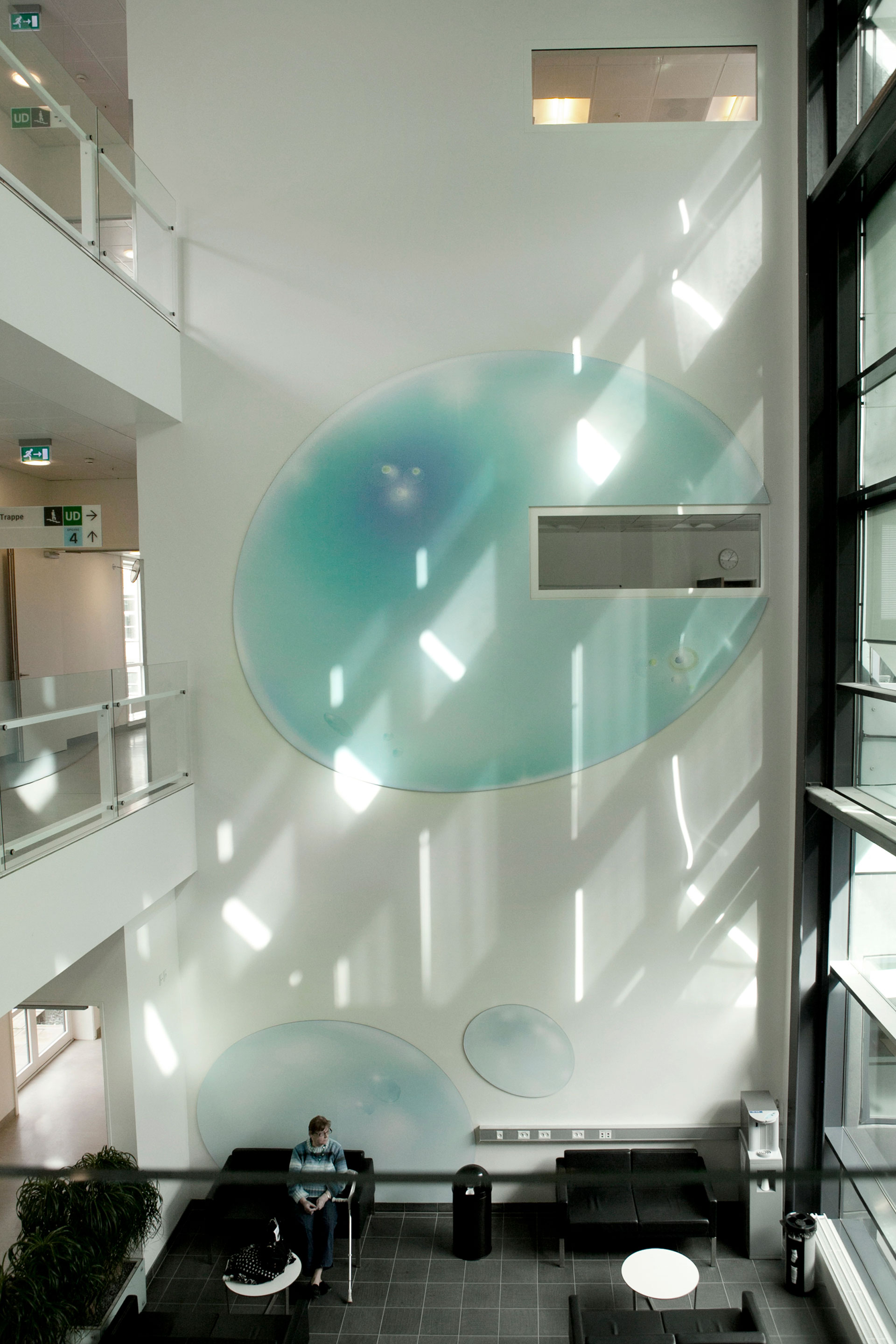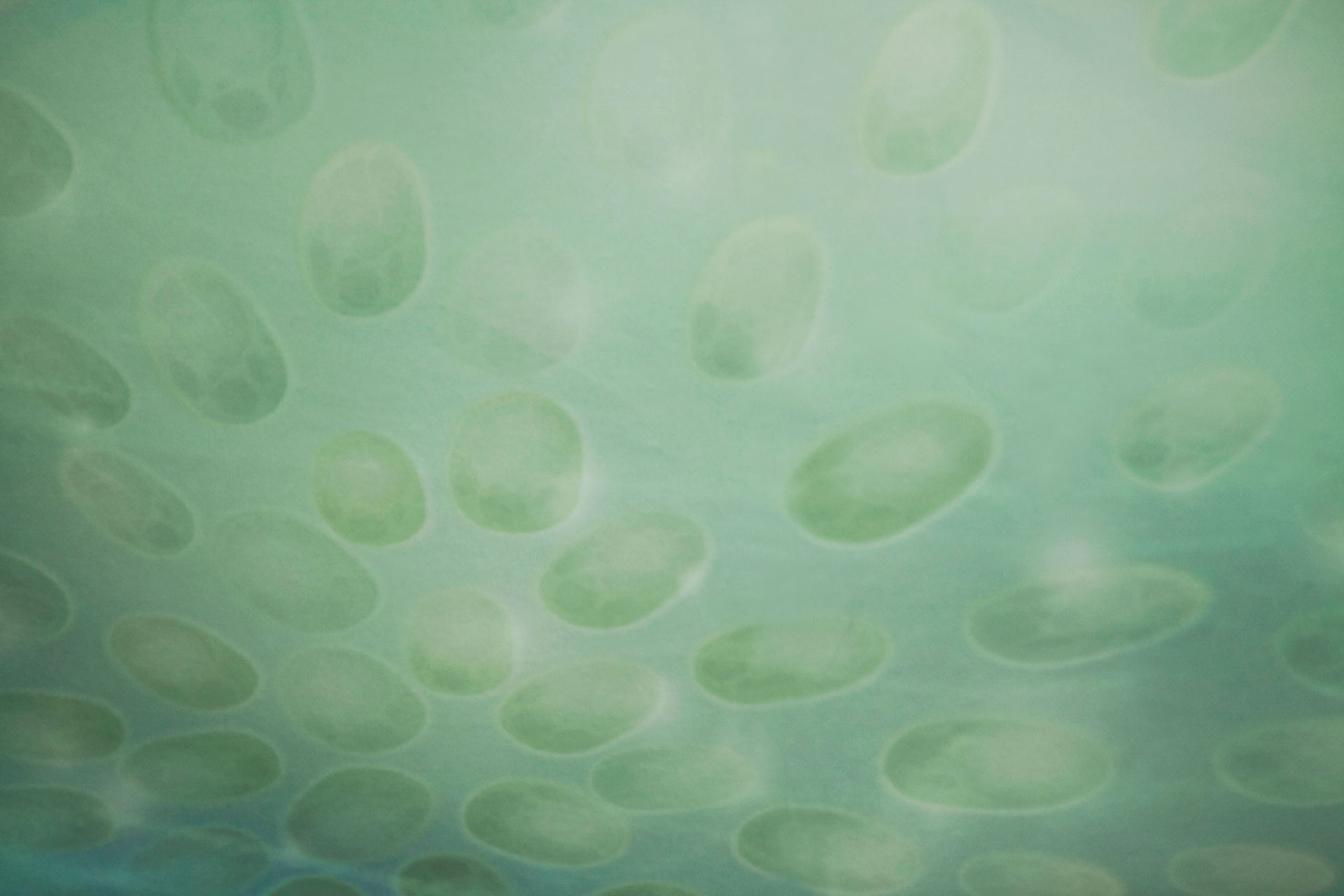The Core
Introduction To Mille Kalsmose’s Art Project At Gentofte Hospital, The Core
By Angelika Dahl Serritzlew, MA History of Art, Courtauld Institute of Art, University of London
Art consultant and external lecturer at the University of Copenhagen
Gentofte Hospital’s old, neo-classicist buildings from 1927 have been expanded on a number of occasions, most recently in 2009 with a large, central building complex designed by C.F. Møller A/S.
This new building complex has been given the name Kernen (The Core), as it is inserted into the former eight-shaped complex as an independent unit that is also connected to what was there before. Around the central axis and buildings of Kernen a number of green courtyards have been planned which, like a cell membrane, a life-giving green belt around Kernen, mediate the transition between the new and the old buildings.
With Kernen, Gentofte Hospital also acquired a new main entrance that has created some new, interesting frameworks for the reception of those using the hospital. Gentofte Hospital management commissioned Mille Kalsmose to decorate the inner areas at the new main entrance, and Mille Kalsmose has called this site-specific art project by the English name The Core.
The general title The Core shows that Mille Kalsmose has the real world as her artistic point of departure – both the actual outer world and our actual inner world: The Core refers to a direct dialogue with the new architecture and the physical space in Kernen, where the works are positioned, but the title also refers to the visual source and inspirational framework that Mille Kalsmose has used in all four of her works, namely our own inner cell world.
Basing her project on a large amount of visual material from the work at Gentofte Hospital, including various CT scans and microscopy images of various cell structures and enzymes, Mille Kalsmose has created four works that show our inner world as a living organism in bright, light green-blue tints where rest and motion, alteration and structure are presented in a kind of dynamic balance.
The Core
The first work one meets, immediately on entering via the new main entrance is ‘The Core’. This work hangs on the wall in the three-storey high atrium area that is a waiting-room for patients and relatives.
‘The Core’ is a work with three cell-like structures that describe a progressive movement upwards in the interior space, with the largest of the three forms hanging on the wall at first-floor height. It is the tripartite form-structure and its interaction with the particular architectural structure of the atrium – the open space with a three-storey-high end-wall, a continuous glass facade to the one side and a view of corridors on the first and second floors to the other – that somehow complete, or accentuate, the possibility for the atrium area to give a feeling of progression in an upward movement.
When one comes to the hospital as a patient or relative, it is most often in a state of inner unrest, dejection and despondency, often with conscious or subconscious worries about one’s own, or a relative’s future health. And when one sits in a waiting area at a hospital, one’s mental state can very easily be influenced in a decidedly unhelpful direction by a whole range of external stress factors that can be embedded in the architecture, decoration, media, sound, etc. A number of international studies have pointed out that if patients are exposed to stress-inducing sensory experiences while sitting in waiting areas, the raised level of stress and unrest will influence the patient’s meeting and dialogue with hospital staff. So it is of crucial importance what sort of interior spaces the patient finds himself or herself in, and what sort of sensory experiences the patient is offered before this meeting with the staff takes place.
At Gentofte Hospital, the work ‘The Core’ meets the patient where the patient is – both physically and mentally. When the patient enters the atrium area and sits down in the waiting section, the work meets the viewer, quite literally, at eye-level. The work is structured in such a way that the first cell-form is anchored at the bottom of the wall, the next one hovers slightly up the wall and leads one’s gaze further up to the largest of the three cell-forms. In that way, the work causes a worried mind to direct its gaze upwards towards a large, round ‘cell world’ where it can calmly investigate the green-blue cell with its pinkish, shiny areas – and a window that points in toward ‘another world’. The work offer patients an opportunity to look up, and it offers patients and relatives a visual space that is in no way insistent, but in every way encourages one to explore and examine the harmonious dynamism of the quiet colors.
Knees
On the first floor hangs a similar large work, ‘Knees’, on the end-wall in a doubly high space that functions as a waiting area for out-patients. Mille Kalsmose has created the work by processing cross-section images of knees and has then given these images an artistic and colourful expression. One can recognise the round, organic form of the knee and the body’s cells, but one is also introduced to a completely new colour world in the interior of the body. ‘Knees’ is a work which – like ‘The Core’ – invites the patient and the relative to gaze upwards in an exciting and imaginative way and explore a world of colours and forms, light and lightness, life and dynamism.
As artistic expressions, ‘The Core’ and ‘Knees’ indicate that the body and our cells contain some incredible life-processes and fascinating inner worlds. In the two other works of The Core, ‘Micro Cells’ and ‘Enzymes’, Mille Kalsmose indicates another just as decisive aspect of the life-processes in the cells of the body: the cell’s membrane, i.e. that area of the cell that mediates the transition between the inside and outside of the cell, between what happens inside the cell and what happens in interaction with the world outside the cell.
Micro Cells
The work ‘Micro Cells’ is an installation of large photostats with images of artistically processed cells. The work has been positioned in such a way that it both functions as a work of art and screens off the waiting area on the first floor. In that way, ‘Micro Cells’ defines the transition between a passive and an active area, i.e. the waiting area and the corridor area on the other side. The work meets this spatial ‘transitional field’ with a visual expression that shows a dynamic, overlapping, wavelike movement of cell forms in green-blue tints. And it is interesting how this visual expression, the form and movement in the work, defines the various forms of activity that are in the space.
When one sits in the waiting area, the overlapping movements of the forms are felt to be calm, anchored to the legs of the photostat. When one goes out into the corridor area, the work is felt to be more dynamic and rhythmic when one meets it with physical movement. ‘Micro Cells’ is thus capable of interacting with the viewer in the waiting room and in the corridor area, and at the same time also to function as a mediator between the two different activities on each side of the work.
Enzymes
The same applies to the work ‘Enzymes’ on the ground floor. This work is also able to mediate an exciting transition between a dynamic corridor area and a calm café area. ‘Enzymes’ consists of artistically processed and greatly magnified images of enzymes that have been set up on a glass wall that forms the transition between the hospital café and the corridor area in front of the main entrance’s Information.
The work not only offers the guests at the café something that screens them off from a hectic area where many people often pass. It also offers a visual experience of oblong, rounded forms in bright, light green-blue tints, with certain pink colours interacting, that create a sense of calm in the area, and it clearly defines the transition between the café area and the Information area. One can see who is coming, but is not disturbed by the activity. And just as with ‘Micro Cells’, this work is also able to enter into a dialogue with both a passive, seated viewer and with an active viewer who is moving along the work. When one goes out into the corridor, it feels as if the oblong enzymes shapes of the work shift in a horizontal movement, catch the physical movement and the direction of the body. With its interesting forms, colours and calm dynamics, this work creates a dialogue space with the viewer, encouraging this viewer to slow down slightly, and thereby the work also motivates calmer and socially agreeable behaviour in this corridor area.
The Core is a decorative assignment that has succeeded in creating a number of works that both relate to the architectural frameworks and to human conditions. The works offer both patients, relatives and staff at Gentofte Hospital a visual sensory experience that emphasises in a way the best qualities of the interior space, while also offering a ‘non-stressful’, calming and interesting experience of the world of the body and the cells. None of the four works of The Core, however, contain any figurative narrative. They only point to a possible world within the body and the cells, presented in a more or less abstract artistic formal language that shows a processed representation of the structures inside us. But if the works do contain a narrative, it is an open one – the individual is free to experience and interpret Mille Kalsmoses artistic processing of the inner worlds of body and cells as he or she wishes – their beauty, their tranquillity and pulsing dynamism, the imaginative play of colours and gleaming universes.













